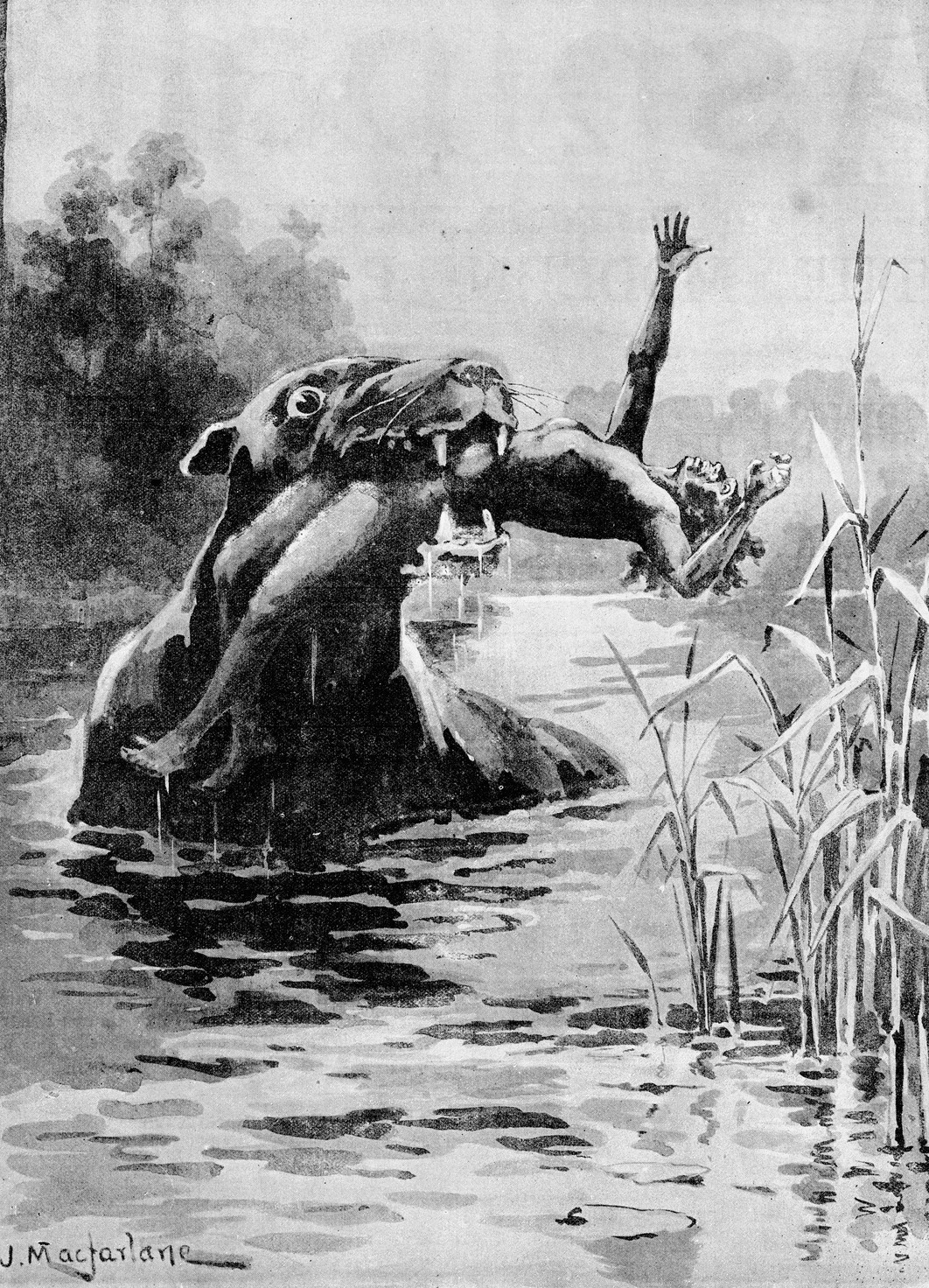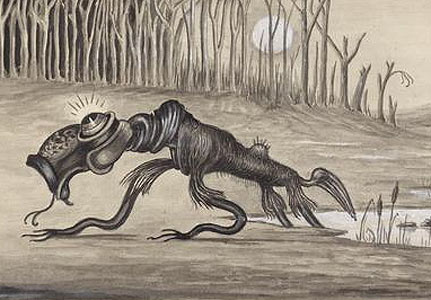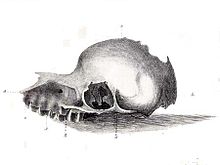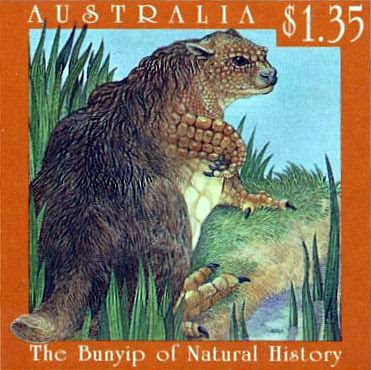
The bunyip, or kianpraty, is a large mythical creature from Aboriginal mythology said to lurk in swamps, billabongs, creeks, riverbeds and waterholes. The origin of the word bunyip has been traced to the Wemba Wemba or Wergaia language of Aboriginal people of South-Eastern Australia. However, the bunyip appears to have formed part of traditional Aboriginal beliefs and stories throughout Australia, although its name varied according to tribal nomenclature. In his 2001 book, writer Robert Holden identified at least nine regional variations for the creature known as the bunyip across Aboriginal Australia. Various written accounts of bunyips were made by Europeans in the early and mid-19th century, as settlement spread across the country.
Meaning
The word bunyip is usually translated by Aboriginal Australians today as “devil” or “evil spirit”. However, this translation may not accurately represent the role of the bunyip in Aboriginal mythology or its possible origins before written accounts were made. Some modern sources allude to a linguistic connection between the bunyip and Bunjil, “a mythic ‘Great Man’ who made the mountains and rivers and man and all the animals.” The word bunyip may not have appeared in print in English until the mid-1840s.
By the 1850s, bunyip had also become a “synonym for impostor, pretender, humbug and the like” in the broader Australian community. The term bunyip aristocracy was first coined in 1853 to describe Australians aspiring to be aristocrats. In the early 1990s, it was famously used by Prime Minister Paul Keating to describe members of the conservative Liberal Party Of Australia opposition.
The word bunyip can still be found in a number of Australian contexts, including place names such as the Bunyip River (which flows into Westernport Bay in southern Victoria) and the town of Bunyip, Victoria.
Characteristics

Bunyip (1935), artist unknown, from the National Library of Australia digital collections, demonstrates the variety in descriptions of the legendary creature.
Descriptions of bunyips vary widely. George French Angus may have collected a description of a bunyip in his account of a “water spirit” from the Moorundi people of the Murray River before 1847, stating it is “much dreaded by them… It inhabits the Murray; but…they have some difficulty describing it. Its most usual form…is said to be that of an enormous starfish.” Robert Brough Smyth’s Aborigines of Victoria of 1878 devoted ten pages to the bunyip, but concluded “in truth little is known among the blacks respecting its form, covering or habits; they appear to have been in such dread of it as to have been unable to take note of its characteristics.” However, common features in many 19th-century newspaper accounts include a dog-like face, dark fur, a horse-like tail, flippers and walrus-like tusks or horns or a duck-like bill.
The Challicum bunyip, an outline image of a bunyip carved by Aborigines into the bank of Fiery Creek, near Ararat, Victoria, was first recorded by The Australasian newspaper in 1851. According to the report, the bunyip had been speared after killing an Aboriginal man. Antiquarian Reynell Johns claimed that until the mid-1850s, Aboriginal people made a “habit of visiting the place annually and retracing the outlines of the figure [of the bunyip] which is about 11 paces long and 4 paces in extreme breadth.” The outline image no longer exists.
Debate over origins of the Bunyip
Non-Aboriginal Australians have made various attempts to understand and explain the origins of the bunyip as a physical entity over the past 150 years.
Writing in 1933, Charles Fenner suggested that it was likely that the “actual origin of the bunyip myth lies in the fact that from time to time seals have made their way up the … Murray and Darling (Rivers)”. He provided examples of seals found as far inland as Overand Corner, Loxton, and Conargo and reminded readers that “the smooth fur, prominent ‘apricot’ eyes and the bellowing cry are characteristic of the seal.”
Another suggestion is that the bunyip may be a cultural memory of extinct Australian marsupials such as the Diprotodon, Zygomaturus, Nototherium, or Palorchestes. This connection was first formally made by Dr George Bennett of the Australian Museum in 1871, but in the early 1990s, palaeontologist Pat Vickers-Rich and geologist Neil Archbold also cautiously suggested that Aboriginal legends “perhaps had stemmed from an acquaintance with prehistoric bones or even living prehistoric animals themselves … When confronted with the remains of some of the now extinct Australian marsupials, Aborigines would often identify them as the bunyip.”
They also note that “legends about the mihirung paringmal of western Victorian Aborigines …may allude to the …extinct giant birds the Dromornithidae.”
Another connection to the bunyip is the shy Australasian bittern.
During the breeding season, the male call of this marsh-dwelling bird is a “low pitched boom”; hence, it is occasionally called the “bunyip bird”.
Early accounts of settlers

During the early settlement of Australia by Europeans, the notion that the bunyip was an actual unknown animal that awaited discovery became common. Early European settlers, unfamiliar with the sights and sounds of the island continent’s peculiar fauna, regarded the bunyip as one more strange Australian animal and sometimes attributed unfamiliar animal calls or cries to it. It has also been suggested that 19th-century bunyip lore was reinforced by imported European memories, such as that of the Irish Puca
A large number of bunyip sightings occurred during the 1840s and 1850s, particularly in the southeastern colonies of Victoria, New South Wales and South Australia, as European settlers extended their reach. The following is not an exhaustive list of accounts:
Hume find of 1818
One of the earliest accounts relating to a large unknown freshwater animal was in 1818, when Hamilton Hume and James Meehan found some large bones at Lake Bathurst in New South Wales. They did not call the animal a bunyip, but described the remains indicating the creature as very much like a Hippopotamus or Manatee. The Philosophical Society of Australasia later offered to reimburse Hume for any costs incurred in recovering a specimen of the unknown animal, but for various reasons, Hume did not return to the lake. It might be noted that Diprotodon skeletons have sometimes been compared to the hippopotamus; they are a land animal, but have sometimes been found in a lake or water course.
Wellington Caves fossils, 1830
More significant was the discovery of fossilised bones of “some quadruped much larger than the ox or buffalo” in the Wellington Caves in mid-1830 by bushman George Rankin and later by Thomas Mitchell. Sydney’s Reverend John Dunmore Lang announced the find as “convincing proof of the deluge”. However, it was British anatomist Sir Richard Owen who identified the fossils as the gigantic marsupials Nototherium and Diprotodon. At the same time, some settlers observed “all natives throughout these… districts have a tradition (of) a very large animal having at one time existed in the large creeks and rivers and by many it is said that such animals now exist.”
First written use of the word bunyip, 1845
In July 1845, The Geelong Advertiser announced the discovery of fossils found near Geelong, under the headline “Wonderful Discovery of a new Animal”. This was a continuation of a story on ‘fossil remains’ from the previous issue. The newspaper continued, “On the bone being shown to an intelligent black (sic), he at once recognised it as belonging to the bunyip, which he declared he had seen. On being requested to make a drawing of it, he did so without hesitation.” The account noted a story of an Aboriginal woman being killed by a bunyip and the “most direct evidence of all” – that of a man named Mumbowran “who showed several deep wounds on his breast made by the claws of the animal”. The account provided this description of the creature:
“The Bunyip, then, is represented as uniting the characteristics of a bird and of an alligator. It has a head resembling an emu, with a long bill, at the extremity of which is a transverse projection on each side, with serrated edges like the bone of the stingray. Its body and legs partake of the nature of the alligator. The hind legs are remarkably thick and strong, and the fore legs are much longer, but still of great strength. The extremities are furnished with long claws, but the blacks say its usual method of killing its prey is by hugging it to death. When in the water it swims like a frog, and when on shore it walks on its hind legs with its head erect, in which position it measures twelve or thirteen feet in height.”
Shortly after this account appeared, it was repeated in other Australian newspapers. However, it appears to be the first use of the word bunyip in a written publication.
The Australian Museum’s bunyip of 1847

In January 1846, a peculiar skull was taken from the banks of Murrumbidgee River near Balranald, New South Wales. Initial reports suggested that it was the skull of something unknown to science. The squatter who found it remarked, “all the natives to whom it was shown called [it] a bunyip”. By July 1847, several experts, including W.S. Macleay and Professor Owen, had identified the skull as the deformed foetal skull of a foal or calf. At the same time, however, the so-called bunyip skull was put on display in the Australian Museum (Sydney) for two days. Visitors flocked to see it, and The Sydney Morning Herald said that it prompted many people to speak out about their “bunyip sightings”. Reports of this discovery used the phrase ‘Kine Pratie’ as well as Bunyip and explorer William Hovell, who examined the skull, also called it a ‘katen-pai’.
In March of that year ‘a bunyip or an immense Platibus’ ([Platypus) was sighted ‘sunning himself on the placid bosom of the Yarra, just opposite the Custom House’ in Melbourne. ‘Immeadiately a crowd gathered’ and three men set off by boat ‘to secure the stranger’ who ‘disappeared’ when they were ‘about a yard from him’.
William Buckley’s account of bunyips, 1852
Another early written account is attributed to escaped convict William Buckley in his 1852 biography of thirty years living with the Wathaurong people. His 1852 account records “in… Lake Moodewarri [now Lake Modewarre] as well as in most of the others inland…is a…very extraordinary amphibious animal, which the natives call Bunyip.” Buckley’s account suggests he saw such a creature on several occasions. He adds, “I could never see any part, except the back, which appeared to be covered with feathers of a dusky grey colour. It seemed to be about the size of a full grown calf… I could never learn from any of the natives that they had seen either the head or tail.” Buckley also claimed the creature was common in the Barwon River and cites an example he heard of an Aboriginal woman being killed by one. He emphasized the bunyip was believed to have supernatural powers.
In popular culture and fiction

The word bunyip has been used in other Australian contexts, including The Bunyip newspaper as the banner of a local weekly newspaper published in the town of Gawler, South Australia. First published as a pamphlet by the Gawler Humbug Society in 1863, the name was chosen because “the Bunyip is the true type of Australian Humbug!” The word is also used in numerous other Australian contexts, including the House of the Gentle Bunyip in Clifton Hill, Victoria. There is also a coin-operated bunyip at Murray Bridge, South Australia, at Sturt Reserve on the town’s riverfront.
Numerous tales of the bunyip in written literature appeared in the 19th and early 20th centuries. These included a story in Andrew Lang’s The Brown Fairy Book (1904). The Bunyip of Berkeley’s Creek is a more recent (1973) Australian children’s picture book about a bunyip.
Alexander Bunyip, created by children’s author and illustrator Michael Salmon, first appeared in print in The Monster That Ate Canberra in 1972, Alexander Bunyip went on to appear in many other books and a live-action television series, Alexander Bunyip’s Billabong. A statue of Alexander was opened in front of the Gungahlin Library in 2011. The artwork by Anne Ross, called ‘A is for Alexander, B is for Bunyip, C is for Canberra’ was commissioned by the ACT Government for Gungahlin’s $3.8 million town park.
Bunyips appear in Naomi Noyik’s fantasy novel Tongues of Serpents, and in the short story Bunyip’s Gift in Mind’s Eye by Jackie French.
In the early 1950s, Bertie the Bunyip was a popular character on Channel 3 in Philadelphia.
The 1977 film Dot and the Kangaroo contains a song “The Bunyip (Bunyip Moon)
In the popular indie game Minecraft, on Australian English language choice, a “creeper” is changed to a Bunyip.
In the Nintendo DS version of The Sims, the player will sometimes have the option to buy a pet Bunyip as a special item.
In the 2011 film Toomelah, one of the main characters, Linden, sings a song about a Bunyip.



Pingback: 10 Unsettling Encounters with the World's Cryptids - Urban Ghosts